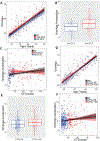Childhood adversity, accelerated GrimAge, and associated health consequences
- PMID: 38762606
- PMCID: PMC11365810
- DOI: 10.1007/s10865-024-00496-0
Childhood adversity, accelerated GrimAge, and associated health consequences
Abstract
Childhood adversity is linked to psychological, behavioral, and physical health problems, including obesity and cardiometabolic disease. Epigenetic alterations are one pathway through which the effects of early life stress and adversity might persist into adulthood. Epigenetic mechanisms have also been proposed to explain why cardiometabolic health can vary greatly between individuals with similar Body Mass Index (BMIs). We evaluated two independent cross-sectional cohorts of adults without known medical illness, one of which explicitly recruited individuals with early life stress (ELS) and control participants (n = 195), and the other a general community sample (n = 477). In these cohorts, we examine associations between childhood adversity, epigenetic aging, and metabolic health. Childhood adversity was associated with increased GrimAge Acceleration (GAA) in both cohorts, both utilizing a dichotomous yes/no classification (both p < 0.01) as well as a continuous measure using the Childhood Trauma Questionnaire (CTQ) (both p < 0.05). Further investigation demonstrated that CTQ subscales for physical and sexual abuse (both p < 0.05) were associated with increased GAA in both cohorts, whereas physical and emotional neglect were not. In both cohorts, higher CTQ was also associated with higher BMI and increased insulin resistance (both p < 0.05). Finally, we demonstrate a moderating effect of BMI on the relationship between GAA and insulin resistance where GAA correlated with insulin resistance specifically at higher BMIs. These results, which were largely replicated between two independent cohorts, suggest that interactions between epigenetics, obesity, and metabolic health may be important mechanisms through which childhood adversity contributes to long-term physical and metabolic health effects.
Keywords: Childhood adversity; Childhood trauma; Epigenetic aging; GrimAge; Health outcomes.
© 2024. The Author(s), under exclusive licence to Springer Science+Business Media, LLC, part of Springer Nature.
Conflict of interest statement
The authors declare no conflicts of interest relevant to this work. This research was supported by National Institutes of Health grants MH101107 (ART), UL1-DE019586 (RS), PL1-DA24859 (RS), R01-AA013892 (RS), NIH R01DA047063 (KX), NIH T32MH019961 (ZMH), and NIH R25MH071584 (ZMH). Z.M.H. is also supported by the Yale Physician Scientist Development Award and CTSA (NIH UL1 TR001863). Dr. Tyrka’s time was additionally supported by P20GM139767 and R01HD086487 (ART). Dr. Daniels received support from MH101076 (ART) and HD101392 (ART). Dr. Kudinova’s time was supported by NIMH (K23MH122587) and NIGMS Bradley Hospital COBRE Center (P20GM139743). Dr. Brick received support from NIDA (R01DA054116).
Figures


Similar articles
-
Early life adversity and age acceleration at mid-life and older ages indexed using the next-generation GrimAge and Pace of Aging epigenetic clocks.Psychoneuroendocrinology. 2022 Mar;137:105643. doi: 10.1016/j.psyneuen.2021.105643. Epub 2021 Dec 23. Psychoneuroendocrinology. 2022. PMID: 34999481
-
Childhood trauma is linked to epigenetic age deceleration in young adults with previous youth residential care placements.Eur J Psychotraumatol. 2024;15(1):2379144. doi: 10.1080/20008066.2024.2379144. Epub 2024 Jul 25. Eur J Psychotraumatol. 2024. PMID: 39051592 Free PMC article.
-
The association between adverse childhood experiences and epigenetic age acceleration in the Canadian longitudinal study on aging (CLSA).Aging Cell. 2023 Feb;22(2):e13779. doi: 10.1111/acel.13779. Epub 2023 Jan 17. Aging Cell. 2023. PMID: 36650913 Free PMC article.
-
All adverse childhood experiences are not equal: The contribution of synergy to adverse childhood experience scores.Am Psychol. 2021 Feb-Mar;76(2):243-252. doi: 10.1037/amp0000768. Am Psychol. 2021. PMID: 33734792 Review.
-
Childhood adversity and accelerated reproductive events: a systematic review and meta-analysis.Am J Obstet Gynecol. 2024 Mar;230(3):315-329.e31. doi: 10.1016/j.ajog.2023.10.005. Epub 2023 Oct 10. Am J Obstet Gynecol. 2024. PMID: 37820985
Cited by
-
Lifetime trauma exposure and accelerated epigenetic aging among midlife women.Health Psychol. 2025 Jun 16:10.1037/hea0001523. doi: 10.1037/hea0001523. Online ahead of print. Health Psychol. 2025. PMID: 40522857 Free PMC article.
-
Epigenetic regulation of brain development, plasticity, and response to early-life stress.Neuropsychopharmacology. 2025 Aug 6. doi: 10.1038/s41386-025-02179-z. Online ahead of print. Neuropsychopharmacology. 2025. PMID: 40770493 Review.
-
Quantification of Epigenetic Aging in Public Health.Annu Rev Public Health. 2025 Apr;46(1):91-110. doi: 10.1146/annurev-publhealth-060222-015657. Epub 2024 Dec 16. Annu Rev Public Health. 2025. PMID: 39681336 Free PMC article. Review.
References
-
- Bremne JD, Vermetten E. Stress and development: behavioral and biological consequences. Dev Psychopathol. 2001;13(3):473–489. - PubMed
-
- Fumagalli F, Molteni R, Racagni G, Riva MA. Stress during development: Impact on neuroplasticity and relevance to psychopathology. Prog Neurobiol. 2007;81(4):197–217. - PubMed
Publication types
MeSH terms
Grants and funding
- R01 DA047063/DA/NIDA NIH HHS/United States
- R25 MH101076/MH/NIMH NIH HHS/United States
- P20 GM139767/GM/NIGMS NIH HHS/United States
- R01DA047063/DA/NIDA NIH HHS/United States
- PL1 DA024859/DA/NIDA NIH HHS/United States
- UL1 DE019586/DE/NIDCR NIH HHS/United States
- K23MH122587/MH/NIMH NIH HHS/United States
- MH101107/MH/NIMH NIH HHS/United States
- R25MH071584/MH/NIMH NIH HHS/United States
- R01 MH101107/MH/NIMH NIH HHS/United States
- MH101076/MH/NIMH NIH HHS/United States
- PL1-DA024859/DA/NIDA NIH HHS/United States
- R01 AA013892/AA/NIAAA NIH HHS/United States
- R01DA054116/DA/NIDA NIH HHS/United States
- K23 MH122587/MH/NIMH NIH HHS/United States
- UL1-TR001863/TR/NCATS NIH HHS/United States
- UL1 TR001863/TR/NCATS NIH HHS/United States
- R01-AA013892/AA/NIAAA NIH HHS/United States
- P20GM139767/GM/NIGMS NIH HHS/United States
- UL1-DE019586/DE/NIDCR NIH HHS/United States
- T32 MH019961/MH/NIMH NIH HHS/United States
- R01HD086487/Eunice Kennedy Shriver National Institute of Child Health and Human Development
- T32 HD101392/HD/NICHD NIH HHS/United States
- HD101392/Eunice Kennedy Shriver National Institute of Child Health and Human Development
- R25 MH071584/MH/NIMH NIH HHS/United States
- R01 DA054116/DA/NIDA NIH HHS/United States
- T32MH019961/MH/NIMH NIH HHS/United States
- P20 GM139743/GM/NIGMS NIH HHS/United States
- P20GM139743/GM/NIGMS NIH HHS/United States
- R01 HD086487/HD/NICHD NIH HHS/United States
LinkOut - more resources
Full Text Sources
Miscellaneous

